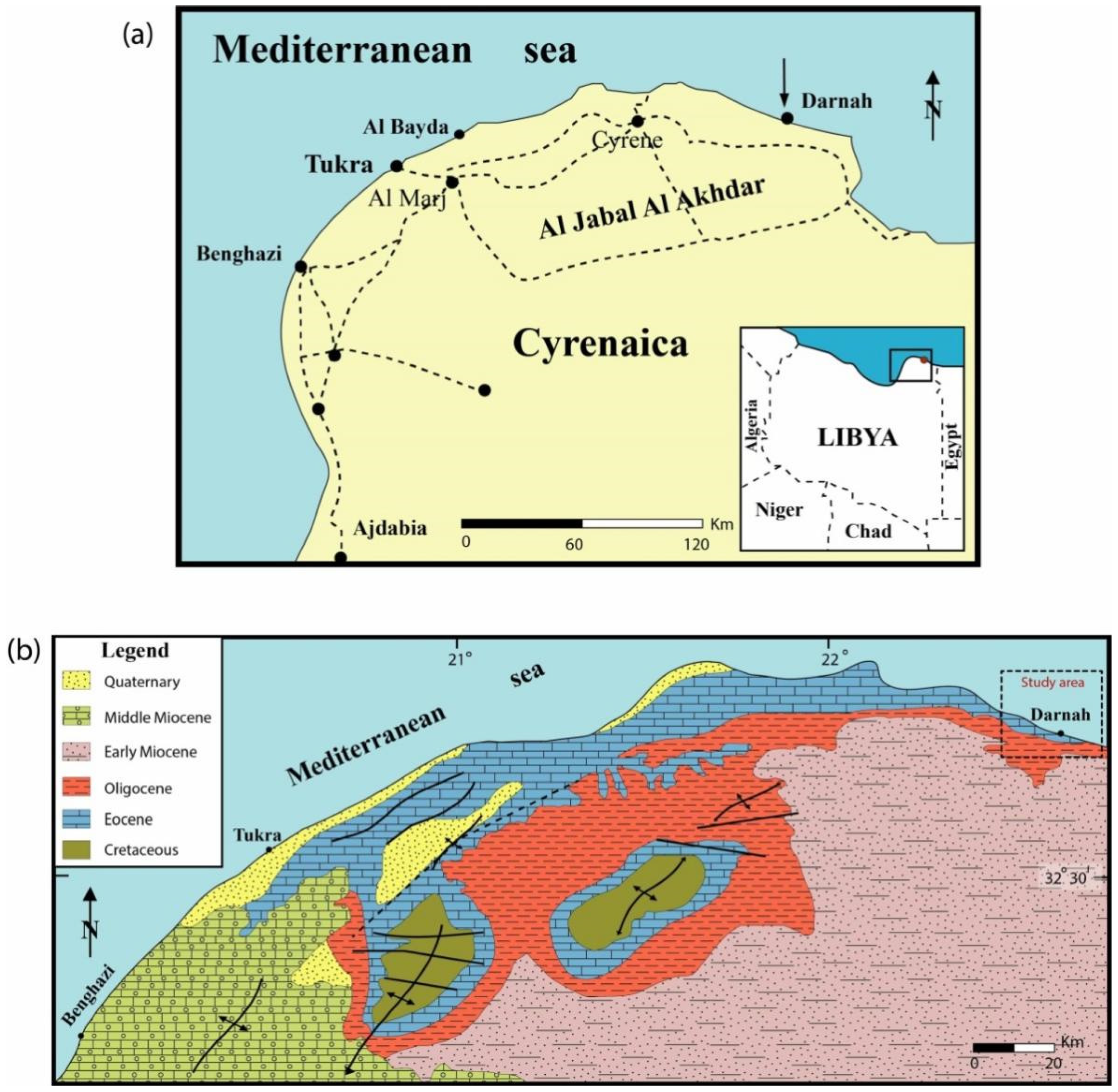First Report of Middle Eocene Micromorphic Brachiopods from Northeastern Libya: Taxonomy and Paleobiogeography Implications
Abstract
1. Introduction
2. Geologic Setting and Stratigraphy
3. Materials and Methods
4. Results
Systematic Palaeontology

- Material: Forty articulated specimens and six separate valves have been collected from the Darnah Formation at the Wadi Darnah area in Northeast Libya.
- Remarks: This species is relatively common in the studied specimens and is represented by juvenile individuals measured 1.3 mm to 4 mm and 1.3 mm to 4 mm. The specimens are well preserved and consistent with those hitherto described by [3,4,6,7,9,26,27,31]. Its shell is small, with the maximum observed length of about 5 mm. It is elongate oval to subtriangular in outline, nearly equally biconvex, ornamented by numerous coarse radial ribs and fine, concentric growth lines. The subcircular foramen is bordered by two small, triangular deltidial plates. The internal structures were not investigated.
- Occurrence: Terebratulina tenuistriata recorded from the Middle Eocene Darnah Formation. This species is distributed in the Eocene of Europe: Great Britain [34], Belgium [35,36], France [25,37,38], Spain [26,31,32], Italy [35,39], Austria [29,33], Poland [40,41], Hungary [27,30,42], Romania [33,43,44], Bulgaria [45], Ukraine [7,46]; Africa: Egypt [3] and Asia: the United Arab Emirates [4]; also, it has been reported from the Oligocene of Italy and Germany [6,9,10].
- Material: Sixty-four articulated specimens and 12 separate valves collected from the Darnah Formation at the Wadi Darnah area in Northeast Libya.
- Remarks: Orthothyris pectinoides is the most common in the studied material, measuring 1.66 mm to 6.25 mm and 1.35 mm to 6.25 mm. It can be easily distinguished from Terebratulina tenuistriata, differing in many characters. The shell of O. pectinoides is biconvex and subcircular in outline; the ventral valve is more convex and ornamented by coarse, radial ribs varying in number from 12 to 18. The hinge line is wide and straight to slightly curved. The beak is high, with sharp ridges and a small, triangular, hypothyroid foramen bordered by elevated deltidial plates. The specimens from the Darnah Formation are similar in size and agree well with those previously described [4,5,6,27,29].
- Occurrence: Orthothyris pectinoides recorded from the Middle Eocene Darnah Formation in this work. This species is recorded in the Eocene of Europe: Germany [47], Austria [29,30], Ukraine [46], Italy [5], Hungary [27], and Asia: The United Arab Emirates [4]. It has also been found in the Oligocene of Germany [6].
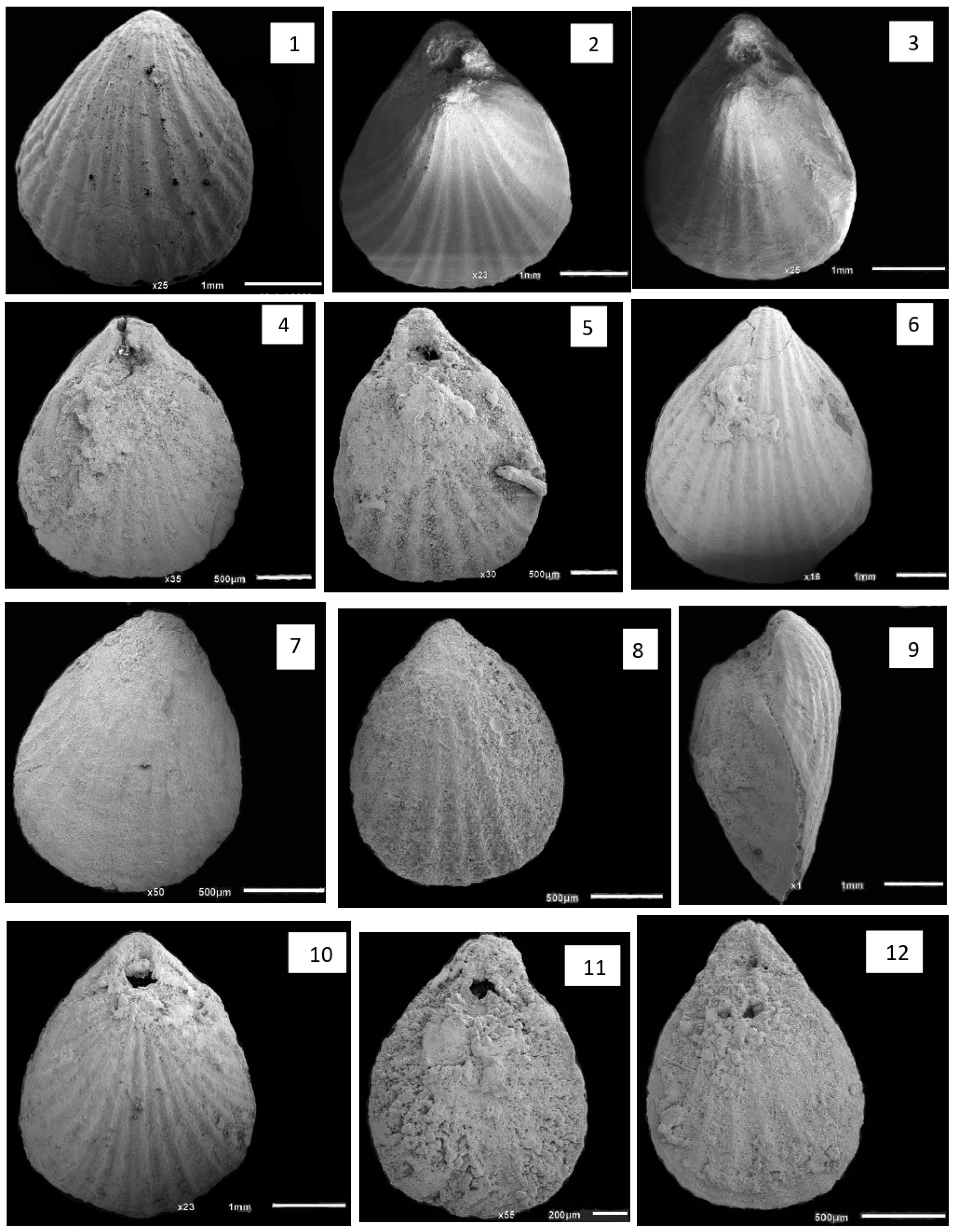
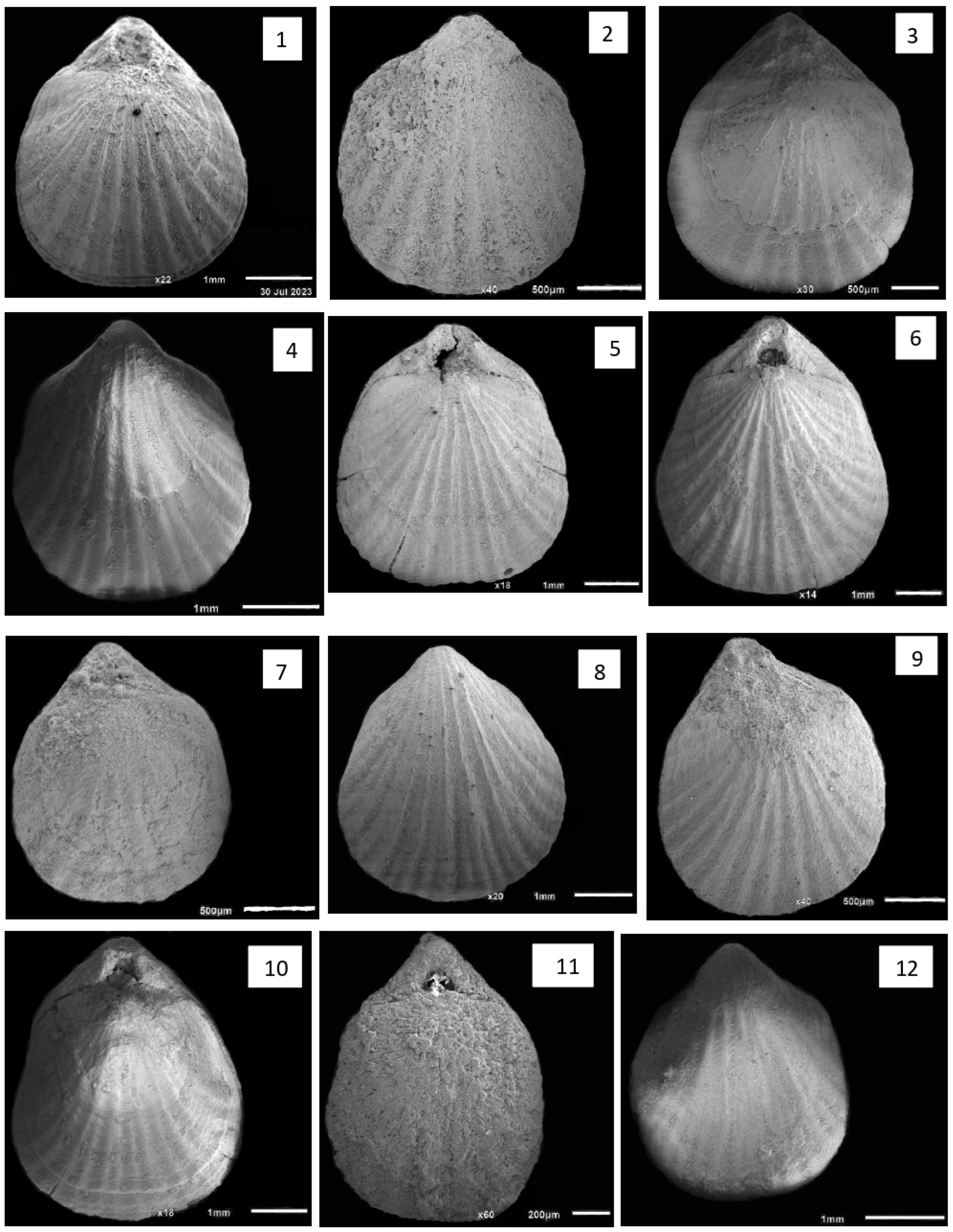
5. Discussion
6. Conclusions
Author Contributions
Funding
Institutional Review Board Statement
Data Availability Statement
Acknowledgments
Conflicts of Interest
References
- Gregory, J.W. The geology of Cyrenaica. Q. J. Geol. Soc. 1911, 67, 572–615. [Google Scholar] [CrossRef]
- Gregory, J.W. The fossil echinoidea of Cyrenaica. Q. J. Geol. Soc. 1911, 67, 661–678. [Google Scholar] [CrossRef]
- Bitner, M.A.; Boukhary, M. First record of brachiopods from the Eocene of Egypt. Nat. Croat. 2009, 18, 393–400. [Google Scholar]
- Bitner, M.A.; Boukhary, M. First record of Eocene brachiopods from the United Arab Emirates, Arabian Gulf and their paleogeographical significance. Neues Jahrb. Geol. Palaontol.-Abh. 2012, 265, 275–279. [Google Scholar] [CrossRef]
- Bitner, M.A.; Dieni, I. Late Eocene brachiopods from the Euganean Hills (NE Italy). Eclogae Geol. Helv. 2005, 98, 103–111. [Google Scholar] [CrossRef]
- Bitner, M.A.; Müller, A. Brachiopods from the Silberberg Formation (Late Eocene to Early Oligocene) of Atzendorf, Central Germany. Paläontologische Z. 2015, 89, 673–688. [Google Scholar] [CrossRef]
- Bitner, M.A.; Müller, A. Late Eocene (Priabonian) brachiopod fauna from Dnipropetrovsk, eastern Ukraine. Bull. Geosci. 2017, 92, 211–231. [Google Scholar] [CrossRef][Green Version]
- Goedert, J.L.; Sandy, M.R.; Peckmann, J. First report of the megathyridid (Terebratellidina) brachiopod Argyrotheca from a hydrocarbon seep deposit, middle Eocene Humptulips Formation, Washington State, USA. PalZ 2021, 95, 97–103. [Google Scholar] [CrossRef]
- Bitner, M.A.; Müller, A. Early Oligocene brachiopods from the rocky-shore deposits at Mammendorf, central Germany. Ann. Soc. Geol. Pol. 2022, 92, 87–107. [Google Scholar] [CrossRef]
- Bitner, M.A.; Uchman, A.; Rattazzi, B. Brachiopods from the Palaeogene clastic deposits of north-western Italy. Neues Jahrb. Geol. Paläontologie Abh. 2020, 298, 165–176. [Google Scholar] [CrossRef]
- Sulser, H.; Menkveld-Gfeller, U.; Bolliger, T.; Kürsteiner, P.; Tschanz, K. First record of the brachiopod Erymnaria in the Chruteren Member (Euthal Formation) from a new Palaeogene site in the Brülisau Schuppenzone of northeastern Switzerland (Canton St. Gallen) with remarks on shell asymmetry. Swiss J. Geosci. 2022, 115, 6. [Google Scholar] [CrossRef]
- Cooper, G.A. Genera of Tertiary and Recent rhynchonelloid brachiopods. Smiths. Misc. Collect. 1959, 139, 1–90. [Google Scholar]
- Barr, F.; Berggren, W.A. Lower Tertiary Biostratigraphy and Tectonics of Northeastern Libya. Geol. Libya 1980, 1, 163–192. [Google Scholar]
- El-Hawat, A.; Abdulsamad, E. Geology and archeology of Cyrenaica, northeastern Libya. In Field Trip Guidebooks, Proceedings of the 32nd International Geological Congress, Florence, Italy, 20–28 August 2004; ISPRA Istituto Superiore per la Protezione e la Ricerca Ambientale: Roma, Italy; p. 29.
- Zert, B. Geological Map of Libya, 1: 250.000: Sheet Darnah NI 34-16. Explanatory Booklet; Industrial Research Centre: Tripoli, Libya, 1974; 49p. [Google Scholar]
- Röhlich, P. Geological Map of Libya, 1: 250 000. Sheet Al Bayda (NI 34–15). Explanatory Booklet; Industrial Research Centre: Tripoli, Libya, 1974; 70p. [Google Scholar]
- El Khoudary, R. Middle Eocene planktonic Foraminifera from the Northern Escarpment of Jabal al Akhdar, North Eastern Libya. Rev. Española Micropaleontol. 1980, 12, 339–357. [Google Scholar]
- El Hawat, A. Fine-grained current drift carbonates and associated facies in a slope to shelf shoaling-up sequences; the Eocene, NE Libya. In Proceedings of the 7th European Regional Meeting, Krakow, Poland, May 1986; Ossolineum, Publishing House of the Polish Academy of Sciences: Wrocław, Poland, 1986; pp. 208–210. [Google Scholar]
- Abdulsamad, E.O. Stratigraphy and palaeobiogeography of Tertiary larger foraminifera from AI Jabal al Akhdar (Cyrenaica, NE Libya). G. Geol. 1999, 61, 75–98. [Google Scholar]
- Abdulsamad, E.O. Contribution to the Nummulites taxonomy from the Paleogene sequences of Al Jabal al Akhdar (Cyrenaica, NE Libya). Rev. Paléobiologie 2000, 19, 19–45. [Google Scholar]
- Abdulsamad, E.O.; El-Ekhfifi, S.S.; Muftah, A.M. Stratigraphy and larger benthic foraminifera of Middle Eocene toMiddleMiocene rocks along the Tobruk-Al Bardia scarps, northeastern Cyrenaica, Libya. Stratigraphy 2018, 15, 153–178. [Google Scholar] [CrossRef]
- Al Menoufy, S.; Abd El-Gaied, I.; Abd El-Aziz, S. Eocene–oligocene larger foraminifera from Libya and their palaeoecologic context. Hist. Biol. 2024, 36, 147–164. [Google Scholar] [CrossRef]
- El Mehaghag, A.; Ashahomi, K. Calcareous nannofossil biostratigraphy of the Al Bayda Formation, al Jabal al Akhdar, NE Libya: A short note. J. Nannoplankton Res. 2005, 27, 15–19. [Google Scholar]
- Klen, I. Geological Map of Libya 1:250 000. Sheet. NI 34-14, Benghazi Explanatory Booklet; Industrial Research Centre: Tripoli, Libya, 1974; 49p. [Google Scholar]
- Leymerie, M.A. Mémoire sur le terrain à Nummulites (Epicrétacé) des Corbières et de la Montagne Noire. Mémoires de la Société Géologique de France 1846, 8, 337–373. [Google Scholar]
- Bitner, M.A. Lower Eocene (Middle Ilerdian) brachiopods from the Campo region, Central Pyrenees, north-eas tern Spain. Span. J. Palaeontol. 2000, 15, 117–128. [Google Scholar] [CrossRef]
- Bitner, M.A.; Dulai, A. Eocene micromorphic brachiopods from north-western Hungary. Geol. Carpathica 2008, 59, 31–43. [Google Scholar]
- Dulai, A.; Hradecká, L.; Konzalová, M.; Less, G.; Švábenická, L.; Lobitzer, H. An early eocene fauna and flora from “Rote Kirche” in Gschliefgraben near Gmunden, Upper Austria. Abhandlungen der Geologischen Bundesanstalt 2010, 65, 181–201. [Google Scholar]
- Dulai, A. Late Eocene (Priabonian) micromorphic brachiopods from the Upper Austrian Molasse Zone. Mem. Assoc. Australas. Palaeontol. 2011, 41, 295–313. [Google Scholar]
- Bitner, M.A.; Dulai, A.; Galácz, A. Middle Eocene brachiopods from the Szoc Limestone Formation (Bakony Mountains, Hungary), with a description of a new genus. Neues Jahrb. Geol. Palaontol.-Abh. 2010, 259, 113–128. [Google Scholar] [CrossRef]
- Bitner, M.A.; Astibia, H.; Payros, A. Middle Eocene (Bartonian) brachiopods from the Pamplona Basin, Navarre, South-Western Pyrenees. Batalleria 2016, 23, 1–7. [Google Scholar]
- Astibia, H.; Corral, J.C.; Álvarez-Pérez, G.; López Horgue, M.Á.; Payros, A. Nuevos datos sobre las faunas marinas del Eoceno medio-superior de Navarra (área surpirenaica occidental): Revisión de los fósiles de la colección Ruiz de Gaona. Estud. Geológicos 2020, 76, e130. [Google Scholar] [CrossRef]
- Dulai, A.; Trif, N.; Balc, R. Middle Eocene (Bartonian) brachiopods from Turnu Roşu (Transylvanian Basin, Romania): Oldest record of Megerlia and Kraussinidae. Fragm. Palaeontol. Hung. 2021, 37, 49–64. [Google Scholar] [CrossRef]
- Elliott, G.F. A London Clay Brachiopod. Proc. Geol. Assoc. 1938, 49, 128–134. [Google Scholar] [CrossRef]
- Davidson, T. On Italian Tertiary Brachiopoda. Geol. Mag. 1870, 7, 359–370, 399–408, 460–466. [Google Scholar] [CrossRef]
- Vincent, E. Contribution à la Paléontologie des Terrains Tertiaires de la Belgique. Brachiopodes. In Annales de la Société royale malacologique de Belgique; 1893; pp. 38–64. [Google Scholar]
- Doncieux, L. Catalogue Descriptif des Fossiles Nummulitiques de l’Aude et de l’Hérault; A. Rey: Lyon, France, 1926. [Google Scholar]
- Doncieux, L. Catalogue Descriptif des Fossiles Nummulitiques de l’Aude et de l’Hérauet; A. Rey: Lyon, France, 1905. [Google Scholar]
- Fabiani, R. Tertiary brachiopods from the Veneto region. Mem. Ist. Geol. R. Univ. Padova 1913, 2, 3–42. (In Italian) [Google Scholar]
- Barczyk, W. Brachiopods Terebratulina delheidi Vincent in the Nummulite Eocene of the Tatra Mts. Acta Geol. Pol. 1973, 23, 491–498. [Google Scholar]
- Popiel-Barczyk, E.; Barczyk, W. Eocene brachiopods from Wola Łużańska and Skalniki in the Central Carpathians. Acta Geol. Pol. 1987, 37, 93–104. [Google Scholar]
- Meznerics, I. Die Brachiopoden des ungarischen Tertiärs. Annales Historico-Naturales Musei Nationalis Hungarici 1944, 36, 10–60. [Google Scholar]
- Popescu-Voiteşti, I. Contribution à l’étude de la faune du calcaire nummulitique d’Albeşti (Muscel). Anu. Institutului Geol. României 1911, 4, 1–35. [Google Scholar]
- Fuchs, H. Beitrag zur Kenntnis der Brachiopoden aus der Umgebung Klausenburg (Cluj). Foldt. Kozlony Bull. Hung. Geol. Soc. 1973, 104, 133–135. [Google Scholar]
- Gochev, P. Paläontologische und stratigraphische Untersuchungen über das Eocän von Varna. Zeitsch. Bulgar. Geol. Gesell 1933, 5, 1–82. [Google Scholar]
- Zelinskaya, V.A. Brakhiopody Paleogena Ukrainy; Naukova Dumka: Kiev, Ukraine, 1975; p. 148. [Google Scholar]
- von Koenen, A. Das Norddeutsche Unter-Oligocän und seine Mollusken-Fauna. Abh. Geol. Spec. Preuss. Thüringischen Staaten 1984, 10, 1250–1392. [Google Scholar]
- Müller, A.; Leder, R.M.; Henninger, M.; Bach, F. Die Silberberg-Formation im Profil von Atzendorf bei Stassfurt (Egelner Nordmulde, Sachsen-Anhalt, Deutschland). Hallesches Jahrb. Für Geowiss. 2014, 36, 73–136. [Google Scholar]
- Smith, A.B. Paleoecology of a molluscan fauna from the Trent Formation. J. Paleontol. 1959, 33, 855–871. [Google Scholar]
- DuBar, J.R. Stratigraphy and Paleontology of the Late Neogene Strata of the Caloosahatchee River Area of Southern Florida; Florida Geological Survey: Tallahassee, Florida, 1958. [Google Scholar]
- Nesbitt, E.A. Paleoecological analysis of molluscan assemblages from the middle Eocene Cowlitz Formation, southwestern Washington. J. Paleontol. 1995, 69, 1060–1073. [Google Scholar] [CrossRef]
- Petuch, E.J. An Unusual Molluscan Assemblage from Venezuela; California Malacozoological Society: Berkeley, CA, USA, 1976. [Google Scholar]
- Saul, L.R. Turritella Zonation Across the Cretaceous-Tertiary boundary, California; University of California Press: Berkeley, CA, USA, 1983; Volume 125. [Google Scholar]
- Allmon, W.D. Ecology of Recent turritelline gastropods (Prosobranchia, Turritellidae): Current knowledge and paleontological implications. Palaios 1988, 3, 259–284. [Google Scholar] [CrossRef]
- Blondeau, A. Les Nummulites; Vuibert: Paris, Franch, 1972; Volume 1, p. 254. [Google Scholar]
- Aigner, T. Fazies und Ereignis-Schichtung im Mittel-und Ober-Eozän von Ägypten. Unpublished Diploma Thesis, University of Tübingen, Tübingen, Germany, 1981; pp. 1–174. [Google Scholar]
- Arni, P. L’évolution des Nummulitinae en tant que facteur de modification des dépôts littoraux. Mémoires BRGM 1965, 32, 7–20. [Google Scholar]
- Logan, A. Geographic distribution of extant articulated brachiopods. In Treatise on Invertebrate Paleontology. Part H. Brachiopoda Revised. Volume 6; Selden, P.A., Ed.; Geological Society of America: Boulder, CO, USA; University of Kansas: Lawrence, KS, USA, 2007; pp. 3082–3115. [Google Scholar]
- Curry, G.B. Ecology and population structure of the recent brachiopod Terebratulina from Scotland. Palaeontology 1982, 25, 227–246. [Google Scholar]
- Curry, G.B. Variable pedicle morphology in a population of the Recent brachiopod Terebratulina septentrionalis. Lethaia 1981, 14, 9–20. [Google Scholar] [CrossRef]
- Bromley, R.G.; Surlyk, F. Borings produced by brachiopod pedicles, fossil and Recent. Lethaia 1973, 6, 349–365. [Google Scholar] [CrossRef]
- Briggs, J.C. Global biogeography. In Developments in Palaeontology and Stratigraphy; Elsevier: Amsterdam, The Netherlands, 1995; Volume 14, pp. 1–452. [Google Scholar]
- Harzhauser, M.; Kroh, A.; Mandic, O.; Piller, W.E.; Göhlich, U.; Reuter, M.; Berning, B. Biogeographic responses to geodynamics: A key study all around the Oligo–Miocene Tethyan Seaway. Zool. Anz.-A J. Comp. Zool. 2007, 246, 241–256. [Google Scholar] [CrossRef]
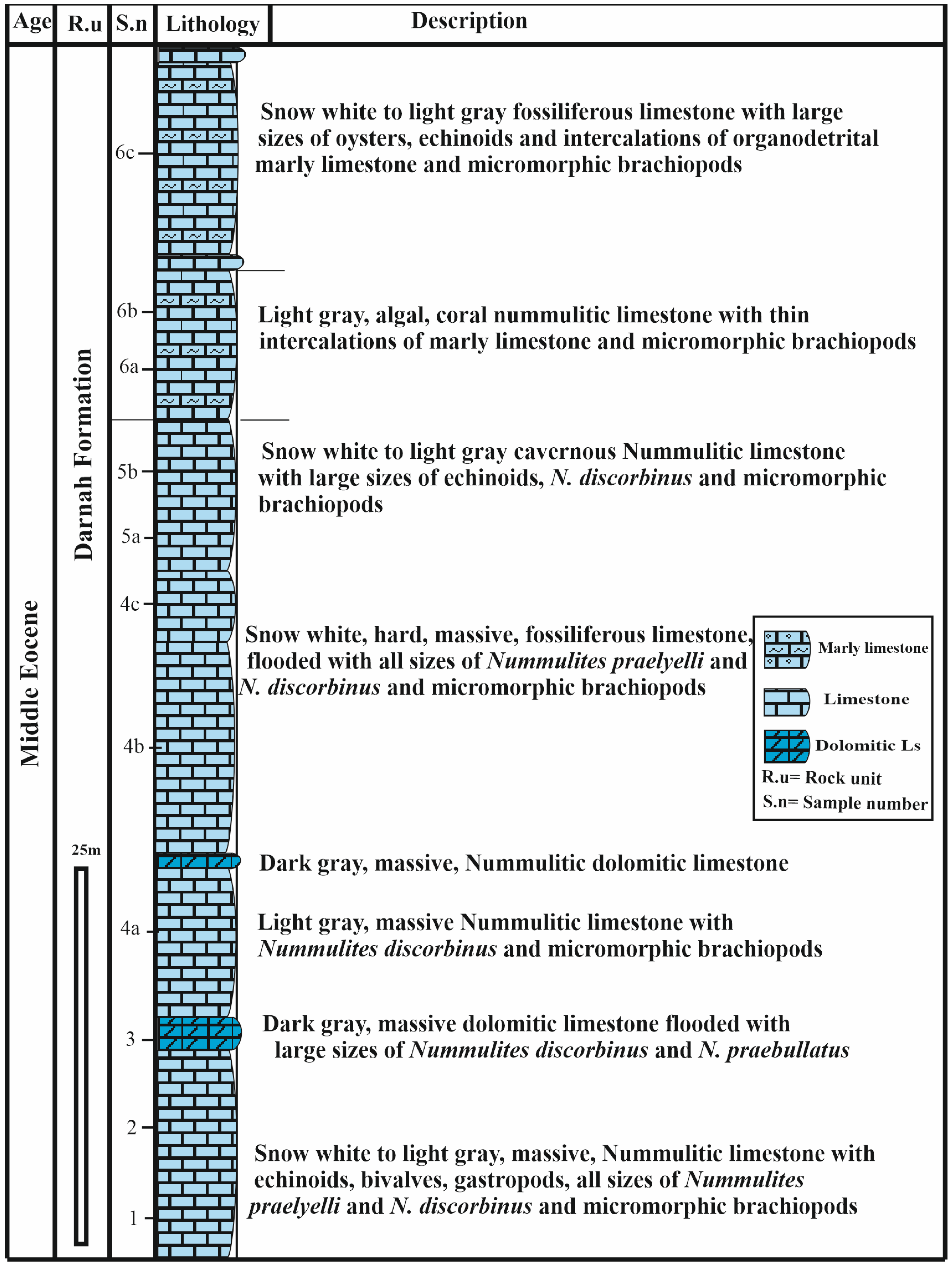
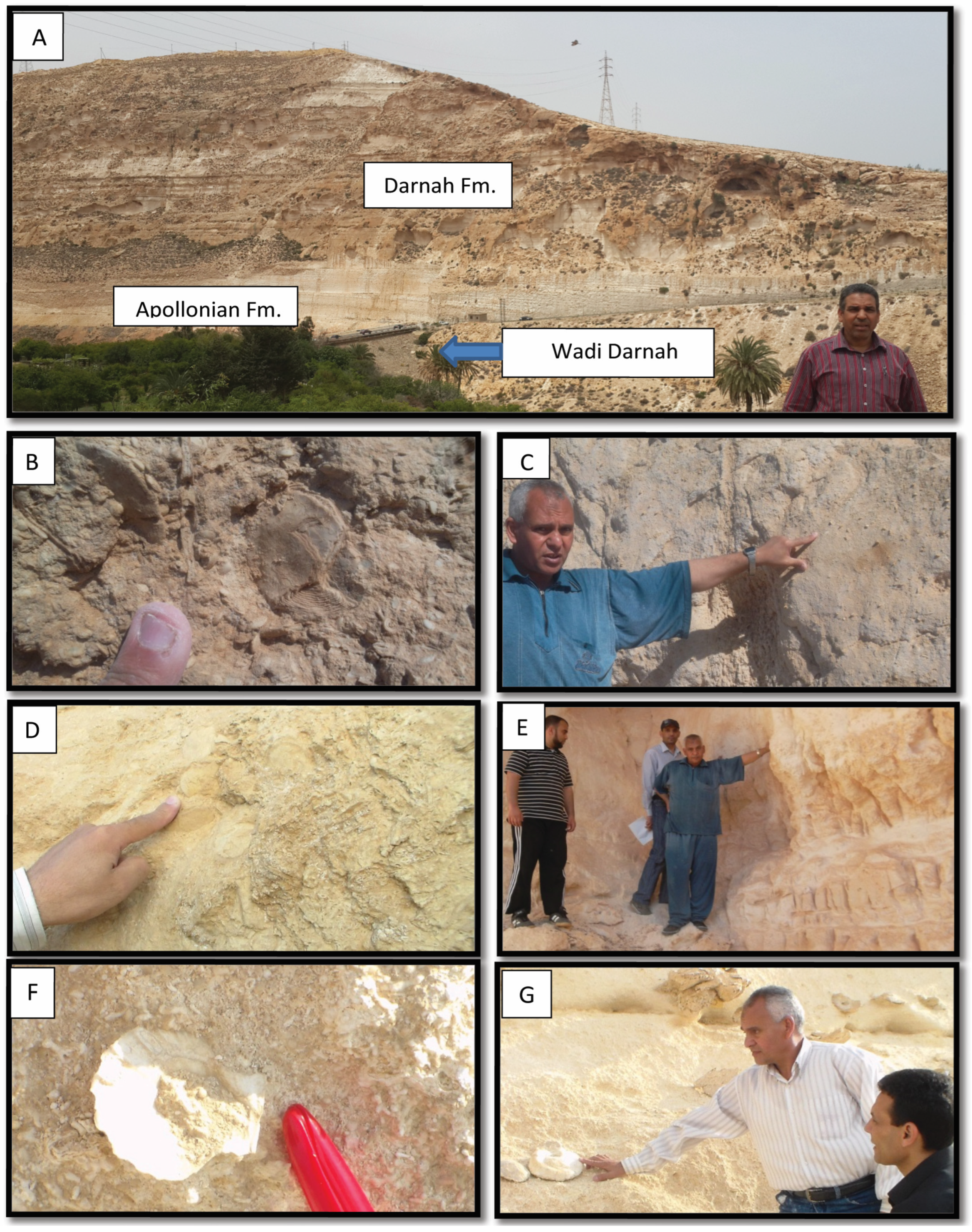
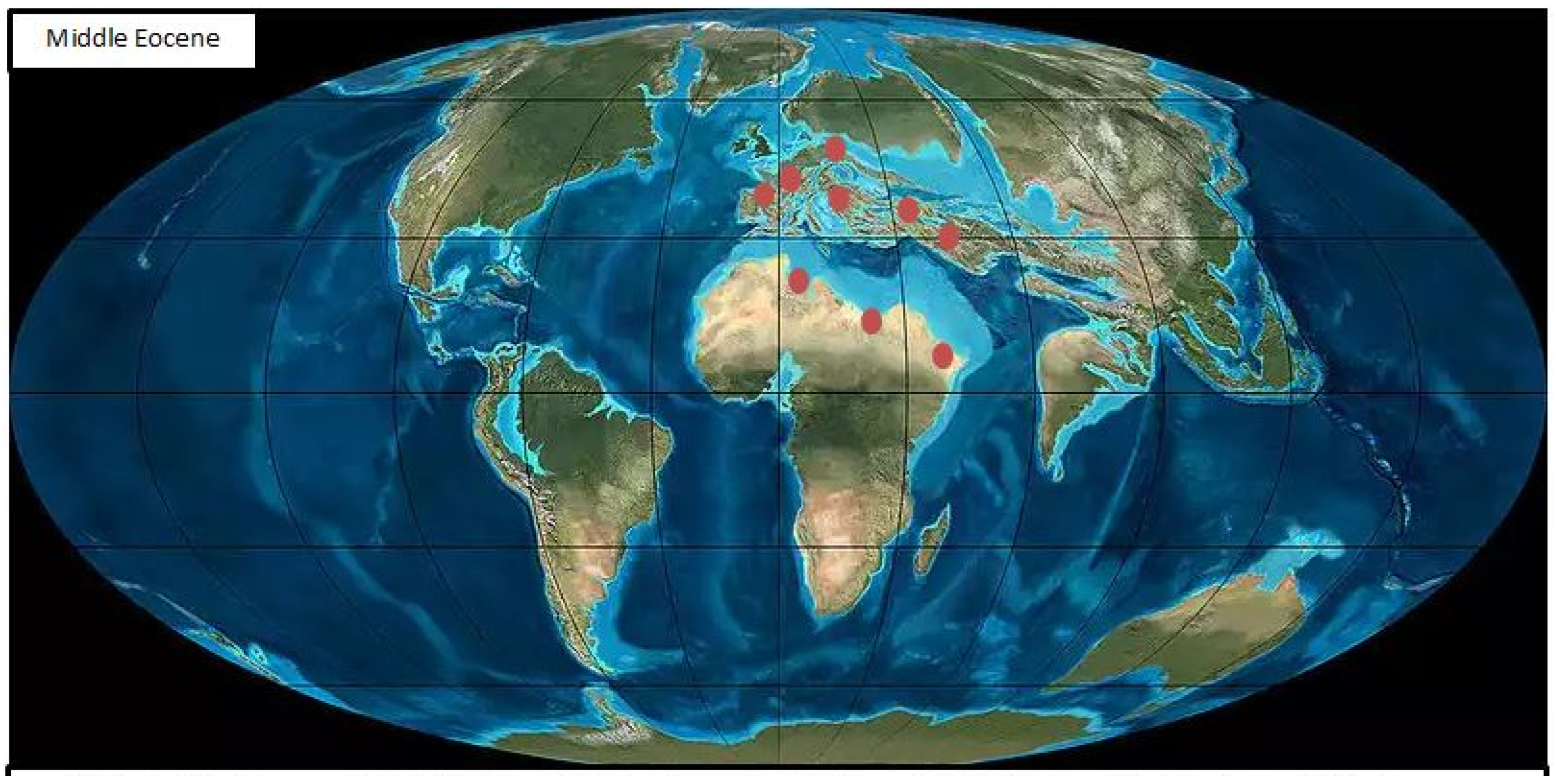
Disclaimer/Publisher’s Note: The statements, opinions and data contained in all publications are solely those of the individual author(s) and contributor(s) and not of MDPI and/or the editor(s). MDPI and/or the editor(s) disclaim responsibility for any injury to people or property resulting from any ideas, methods, instructions or products referred to in the content. |
© 2024 by the authors. Licensee MDPI, Basel, Switzerland. This article is an open access article distributed under the terms and conditions of the Creative Commons Attribution (CC BY) license (https://creativecommons.org/licenses/by/4.0/).
Share and Cite
Abd El-Aziz, S.M.; Abd El-Gaied, I.M.; Al-Hashim, M.H.; Bitner, M.A.; Salama, Y.F.; Heinz, P.; Sayed, M.M. First Report of Middle Eocene Micromorphic Brachiopods from Northeastern Libya: Taxonomy and Paleobiogeography Implications. Diversity 2024, 16, 672. https://doi.org/10.3390/d16110672
Abd El-Aziz SM, Abd El-Gaied IM, Al-Hashim MH, Bitner MA, Salama YF, Heinz P, Sayed MM. First Report of Middle Eocene Micromorphic Brachiopods from Northeastern Libya: Taxonomy and Paleobiogeography Implications. Diversity. 2024; 16(11):672. https://doi.org/10.3390/d16110672
Chicago/Turabian StyleAbd El-Aziz, Sayed M., Ibrahim M. Abd El-Gaied, Mansour H. Al-Hashim, Maria Aleksandra Bitner, Yasser F. Salama, Petra Heinz, and Mostafa M. Sayed. 2024. "First Report of Middle Eocene Micromorphic Brachiopods from Northeastern Libya: Taxonomy and Paleobiogeography Implications" Diversity 16, no. 11: 672. https://doi.org/10.3390/d16110672
APA StyleAbd El-Aziz, S. M., Abd El-Gaied, I. M., Al-Hashim, M. H., Bitner, M. A., Salama, Y. F., Heinz, P., & Sayed, M. M. (2024). First Report of Middle Eocene Micromorphic Brachiopods from Northeastern Libya: Taxonomy and Paleobiogeography Implications. Diversity, 16(11), 672. https://doi.org/10.3390/d16110672






